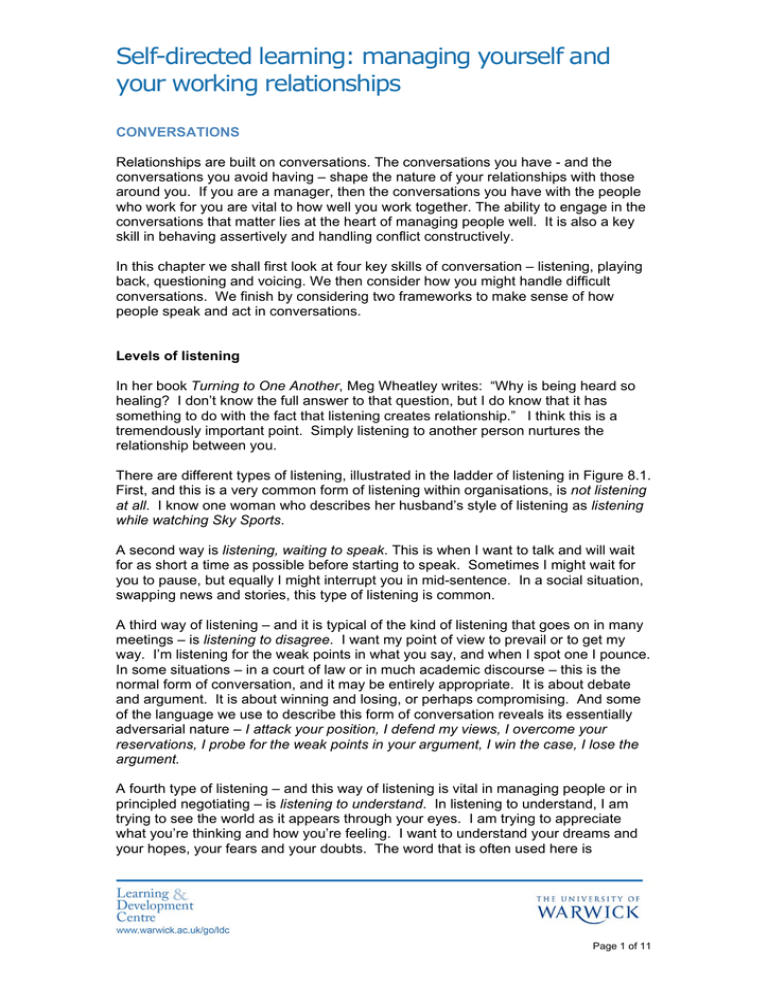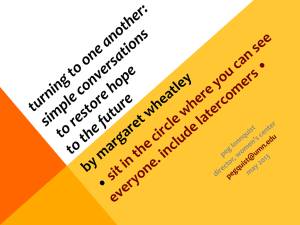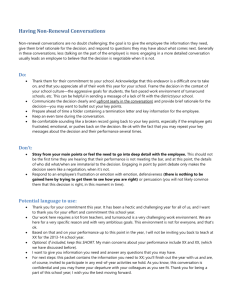Self-directed learning: managing yourself and your working relationships
advertisement

Self-directed learning: managing yourself and your working relationships CONVERSATIONS Relationships are built on conversations. The conversations you have - and the conversations you avoid having – shape the nature of your relationships with those around you. If you are a manager, then the conversations you have with the people who work for you are vital to how well you work together. The ability to engage in the conversations that matter lies at the heart of managing people well. It is also a key skill in behaving assertively and handling conflict constructively. In this chapter we shall first look at four key skills of conversation – listening, playing back, questioning and voicing. We then consider how you might handle difficult conversations. We finish by considering two frameworks to make sense of how people speak and act in conversations. Levels of listening In her book Turning to One Another, Meg Wheatley writes: “Why is being heard so healing? I don’t know the full answer to that question, but I do know that it has something to do with the fact that listening creates relationship.” I think this is a tremendously important point. Simply listening to another person nurtures the relationship between you. There are different types of listening, illustrated in the ladder of listening in Figure 8.1. First, and this is a very common form of listening within organisations, is not listening at all. I know one woman who describes her husband’s style of listening as listening while watching Sky Sports. A second way is listening, waiting to speak. This is when I want to talk and will wait for as short a time as possible before starting to speak. Sometimes I might wait for you to pause, but equally I might interrupt you in mid-sentence. In a social situation, swapping news and stories, this type of listening is common. A third way of listening – and it is typical of the kind of listening that goes on in many meetings – is listening to disagree. I want my point of view to prevail or to get my way. I’m listening for the weak points in what you say, and when I spot one I pounce. In some situations – in a court of law or in much academic discourse – this is the normal form of conversation, and it may be entirely appropriate. It is about debate and argument. It is about winning and losing, or perhaps compromising. And some of the language we use to describe this form of conversation reveals its essentially adversarial nature – I attack your position, I defend my views, I overcome your reservations, I probe for the weak points in your argument, I win the case, I lose the argument. A fourth type of listening – and this way of listening is vital in managing people or in principled negotiating – is listening to understand. In listening to understand, I am trying to see the world as it appears through your eyes. I am trying to appreciate what you’re thinking and how you’re feeling. I want to understand your dreams and your hopes, your fears and your doubts. The word that is often used here is Page 1 of 11 Self-directed learning: managing yourself and your working relationships empathy. Note that when you understand someone’s point of view, this doesn’t necessarily mean that you agree with them. Figure 8.1 Levels of listening Listening to understand Listening to disagree Listening, waiting to speak Not listening Listening with the head, the heart and the gut Another model to illustrate different ways of listening uses the metaphors of listening with the head, the heart and the gut. Listening with your head means focusing on the words that the other person actually says. At a thinking level, they are communicating facts, information, arguments, ideas and concepts. You might imagine that they are communicating from their head to your head, and you may speak back from your head to their head. However, people communicate at a feelings level too. They may vocalise their feelings – I’m angry, I feel sad, This is so exciting, and so on. Often, however, the Page 2 of 11 Self-directed learning: managing yourself and your working relationships words spoken may be only the tip of the iceberg and the feelings that lie beneath the words may be expressed non-verbally – through tone of voice, or body language, or facial expression. To listen effectively you need to tune into what is not being said. You might call listening at a feelings level listening with your heart. At a deeper level still, you might listen with your gut – that is, with your intuition – and pick up messages that are there but again are not spoken. Sometimes your gut tells you things well before your intellect catches on. With your gut, you might hear about the other person’s fears or hopes or needs. Figure 8.2 illustrates these three levels of listening using an analogy with an iceberg. Above the surface you pick up with your head the words that are actually said. Below the surface you pick up with your heart and your gut what is not said – the emotions, fears, hopes, and so on. Figure 8.2 Listening with the head, the heart and the gut With your head you hear: What is actually said: • • • • • Words Facts Information Task Formal agenda With your heart and with your intuition you hear: What is not said: • • • • • • • Intentions Motivations Needs Fears Aspirations Power struggles Informal agenda Playing back The second conversational skill, which is an excellent way of showing the other person that you have been listening to them, is to play back your understanding of what they’ve said or perhaps communicated non-verbally. In a coaching context I use three main ways of playing back to the client my understanding of what they’ve said. Page 3 of 11 Self-directed learning: managing yourself and your working relationships First, I will summarise to play back my understanding of the key points. I might, for instance, say something like You seem to be saying that there are three issues here ….. ….. I will often use a summary to cover an extended piece of conversation. Second, I will paraphrase what the client has said, turning their words into a different formulation. For instance, the other person might say It feels like I’m banging my head against a brick wall, and I might respond with It sounds like you’re feeling very frustrated and perhaps a bit angry. Third, I will reflect back to the client what they have said, repeating their exact words. Sometimes there is energy or significance in the precise words or metaphors that someone uses, and it can be powerful to stay with their exact language. In the previous illustration, for example, I might respond with Tell me more about what it’s like to be banging your head against a brick wall. Or sometimes there might be a single word that seems pregnant with significance, perhaps indicated by the tone of voice of the client. I find that playing back your understanding is a very useful way of managing a conversation. It helps to check or modify your understanding of the other person’s position. Moreover, when people feel that they have been heard and understood, they are likely to be ready to move on in the conversation. Playing back also gives you time to think about where to go next in the conversation. Questioning The third conversational skill is the ability to ask open questions that invite the other person to explore or explain their position in some detail. In coaching, for example, a good question is one that helps the client to think. It is very useful to distinguish between open and closed questions. As an illustration, consider the difference between the closed question Was it the signal which caused the accident? and the open question What caused the accident? The latter is more likely to generate far more information. Open questions usually begin with Kipling’s trusted friends: I keep six honest serving-men (They taught me all I knew); Their names are What and Why and When And How and Where and Who. A word of caution about asking a question beginning with Why? This can often come across as unduly challenging and might provoke defensiveness in the other person, who may feel forced to justify their views. It is easy to soften a Why? question by saying something like I’m interested in what led you to do that or What is your intention in doing this? Note too that these questions are more focused than a simple Why? question – the first example is backward looking and the second example is forward looking. Closed questions, interestingly, generally begin with a verb: Have you …? Are you …? Page 4 of 11 Self-directed learning: managing yourself and your working relationships Could you …? Will you …? Occasionally, a closed question is just what is called for. For instance, you may want to check out if someone really is committed to an action by asking a question such as: So, will you speak to your boss today? I also think that the best questions are short, and the word I like to use in this regard is crisp. A crisp question – simply expressed – invites the other person to focus on the most important issue. You might like to notice the questions that you ask and consider how many words it takes you to ask a question. It is often possible to ask a helpful, crisp question in half a dozen words, or less. Voicing The fourth conversational skill is voicing – the ability to state clearly what you think and the reasons that underlie your thinking. There is a place for small talk and polite conversation. When you meet someone for the first time at a party, for instance, it is normal to talk about your journey or the weather or how you know the host. Such small talk may be the first step to a much more meaningful level of engagement. However, it may be important to go beyond polite talk and speak authentically. In Difficult Conversations Douglas Stone, Bruce Patton and Sheila Heen write that: When we fail to share what’s important to us, we detach ourselves from others and damage our relationships. A relationship takes hold and grows when both participants experience themselves and the other as being authentic. It can be both helpful and powerful not merely to state your point of view but also to reveal the thinking that led you to that point of view or to state the reasons why you think something is important. To engage in a meaningful two-way conversation, it is important too to invite others to speak with their authentic voice, asking them to share how they see things and what leads them to see them in that way. As we explored in an earlier chapter, assertiveness is the ability to state clearly and confidently what you want or need in a situation AND to allow the other party to state clearly what they want. Page 5 of 11 Self-directed learning: managing yourself and your working relationships Difficult conversations In their book Difficult Conversations Douglas Stone, Bruce Patton and Sheila Heen set out a framework to understand and to manage difficult conversations. A difficult conversation, they say, is anything you find it hard to talk about. For example, if someone finds it difficult to return a faulty item to a shop, then this is a difficult conversation, even though many other people might find this straightforward. Stone, Patton and Heen’s starting point is that any difficult conversation is actually three conversations: • The “What happened?” conversation: Most difficult conversations involve disagreements about what has happened or what should happen. • The feelings conversation: Every difficult conversation also asks and answers questions about feelings. These feelings may not be addressed directly, but they will leak in anyway. • The identity conversation: This the conversation we each have with ourselves about what this situation means to us. To illustrate these three conversations, imagine that you are talking to one of your staff about how he failed to deliver an important piece of work to the quality that was required. What might be going on for both of you during this conversation? First, there is the what happened? conversation. This might cover issues such as how clear was your briefing, how realistic was the timetable, what resources were available, what else happened to interrupt the work, and so on. Second, there is the feelings conversation. This might never be articulated and one or both of you may not be conscious of your feelings. Nevertheless there will be feelings present. For instance, you may feel disappointed or angry because you think he let you down. He may be upset because he reckons you did not give him enough support. The nature of the relationship between you will influence how much these feelings are explored. Third, there is the identity conversation. This is probably even less likely to be voiced. Perhaps part of your identity is to see yourself as a competent manager who gives all of your staff a lot of support. On this occasion you didn’t give enough support, and this raises questions in your mind about how good a manager you really are. Equally the other person sees himself as a conscientious and reliable worker, and this episode may cause him to question just how dependable he really is. Again the quality of the relationship between you will affect how far this conversation takes place. Even if nothing is said, each of you may be having part of this conversation in your own head. Note the similarity between the three conversations and the idea of listening with the head, heart and gut which we looked at above. Tackling difficult conversations Stone, Patton and Heen suggest that one way of engaging effectively in a difficult conversation is to move from a conversation about who is to blame to a conversation which is focused on learning for next time. Page 6 of 11 Self-directed learning: managing yourself and your working relationships In a blame conversation, you are trying to prove that you were in the right and to place the blame largely or exclusively on the other person. This is likely to be met by some kind of resistance, and you probably end up in a conflict and a win-lose situation where even to “win” might only be of short term benefit. Shifting to a mindset of engaging in a learning conversation means that your purpose changes and you want to share and understand different perspectives and look to construct positive ways forward that will benefit all parties. Shifting from message delivery to learning means that you stop arguing about who is right and start exploring each other’s stories. An important key to having a learning conversation is to distinguish blame from contribution. Rather than arguing about who is to blame, it is far more fruitful to explore what each of us contributed to the situation. Some of the differences in moving from blame to contribution are summarised below: Who is to blame? What is my contribution? Seeks to judge others One sided Looks backwards Provokes defensiveness Hinders problem solving Seeks to understand others Joint and interactive Looks forwards Stimulates learning and change Encourages problem solving Stone, Patton and Heen write that: Talking about blame distracts us from exploring why things went wrong and how we might correct them going forward. Focusing instead on understanding the contribution system allows us to learn about the real causes of the problem, and to work on correcting them. Fierce conversations In her book Fierce Conversations the American executive coach Susan Scott writes about the conversations that get to the heart of the matter. By fierce she does not mean aggressive but rather robust, passionate, eager. Conversations that get to the heart of the matter, that surface assumptions and explore different perspectives take time. They might seem like an indulgence in today’s fast paced organisations. However, the conversations that don’t get to the heart of the matter in the end take up far more time because the decisions and actions “agreed” in these conversations don’t address the full reality of the situation. Susan Scott writes that, “fierce conversations often do take time. The problem is, anything else takes longer.” I sometimes share with a coaching client the following exercise from Susan Scott’s book. I ask them to think of a difficult conversation they would like to have. I then invite them to prepare an opening statement lasting just sixty seconds covering these seven elements: 1) Name the issue 2) Select a specific example that illustrates the behaviour or situation you want to change Page 7 of 11 Self-directed learning: managing yourself and your working relationships 3) 4) 5) 6) 7) Describe your emotions about the issue Clarify what is at stake Identify your contribution to this problem Indicate your wish to resolve the issue Invite your partner to respond Susan Scott argues that it is possible to cover all of these points in sixty seconds as a way of setting up a fierce or difficult conversation. I find that the exercise strikes British people as a bit unrealistic, and it may be easier to envisage this happening in the States. However, noting what they’d like to say under each heading is very useful in helping the other person to identify the key points they’d like to cover in the conversation. I then invite the client to rehearse this opening statement, and together we review how assertively they were able to make this. I may offer some feedback on what came across to me as powerful or weak, or on things like tone of voice or hesitancy of speech. The client then makes the statement a second time, incorporating the points they’ve taken from the review. Note that the above seven steps only set up the conversation. To actually have the conversation in reality, you also need to: 8) Interact with the other person, and in particular find out their views 9) Seek to jointly resolve the issue, emphasising how you can both move forward 10) Reach an agreement Three languages This section sets out a framework described originally by David Kantor. He suggests that people use three different languages to express themselves - power, meaning and affect (or feeling). • Someone who is using the language of power is interested in what we are going to do. • Someone who is using the language of meaning is interested in the ideas and values behind what is happening. • Someone who is using the language of affect is concerned about the feelings of the people involved and the relationships between them. Page 8 of 11 Self-directed learning: managing yourself and your working relationships Figure 8.3 David Kantor’s three languages POWER MEANING AFFECT When I worked in the gas pipeline company Transco, the culture was dominated by the engineers whose activities were at the heart of the business. Transco engineers largely spoke what Kantor calls the language of power. They were most at home when they were active, making decisions and – sometimes literally - fighting fires. They often found it difficult to stand back and reflect. I now work at the University of Warwick where the culture is shaped by the academics who are the key players in the organisation. Academics often talk in the language of meaning, and feel most comfortable debating ideas and producing alternative points of view. However, they can find it difficult to make a decision, particularly in a group. From time to time I facilitate a supervision session for a group of people who teach counselling and psychotherapy. I’ve noticed that they naturally use the language of affect. In Dialogue and the Art of Thinking Together Bill Isaacs writes of Kantor’s three languages that: These are in fact truly different languages: Communication across them carries the same difficulties that translation between any two languages carries. People speaking the language of feeling tend to be discounted by people who speak the language of action and power. Asking such people to reflect about the meaning of things can often evoke the reaction that you are being too “intellectual.” And asking questions about how to take action may feel premature to those communicating via the language of feeling or meaning. As an exercise, place a cross somewhere in the triangle in Figure 8.3 to represent the language that you yourself generally use. For example, if you use a combination of Power and Meaning with little or no Affect, you might place the cross somewhere on the left hand edge. And, when you are in a situation where you are seeking to Page 9 of 11 Self-directed learning: managing yourself and your working relationships influence or negotiate with another person, consider which language they are speaking. You may find it helps to put forward your views in the language which they use rather than your own. Recognising the different languages that people tend to speak can be very useful in managing a meeting. For example, if the purpose of the meeting or an agenda item is to make a decision, some people will be comfortable doing this while others may need you to focus their attention explicitly on the need for a decision. The four player system David Kantor describes a second framework, which he calls the four player system, to explain different stances that people may take in a meeting. Figure 8.4 David Kantor’s four player system MOVE BYSTAND FOLLOW OPPOSE • • • • When someone moves, they are proposing something or initiating an action. When someone follows, they are supporting a move. When someone opposes, they are challenging what is being said or proposed. When someone bystands, they are offering a perspective on what is happening in the conversation. (Note that the term bystanding does not mean being uninvolved or silent.) To illustrate the four roles in the model, let’s imagine that we are in a group discussing how we’ll spend the evening. If I say Let’s go to the cinema, then I’m making a Move. And if you reply There’s a really good film on at the Odeon, then you are Following, seeking to build on my suggestion. However, if you say Oh, we went to the cinema last night, then you are Opposing my idea. And if someone else says That’s the sixth idea we’ve looked at and we still haven’t decided what to do tonight, they are making a Bystanding comment. Page 10 of 11 Self-directed learning: managing yourself and your working relationships David Kantor argues that a healthy conversation requires all of these roles to be played. Moreover, everyone in the conversation is free to occupy any of the four positions. A team in which it isn’t acceptable to oppose the views of the leader or to make a Bystanding comment when the group is stuck is likely to be both unhealthy and less than fully productive. You might like to reflect upon the conversations that take place in your team meetings. Which of these positions dominate the conversation, and which are largely missing? You might also consider which of the stances you yourself typically take in meetings. Page 11 of 11





